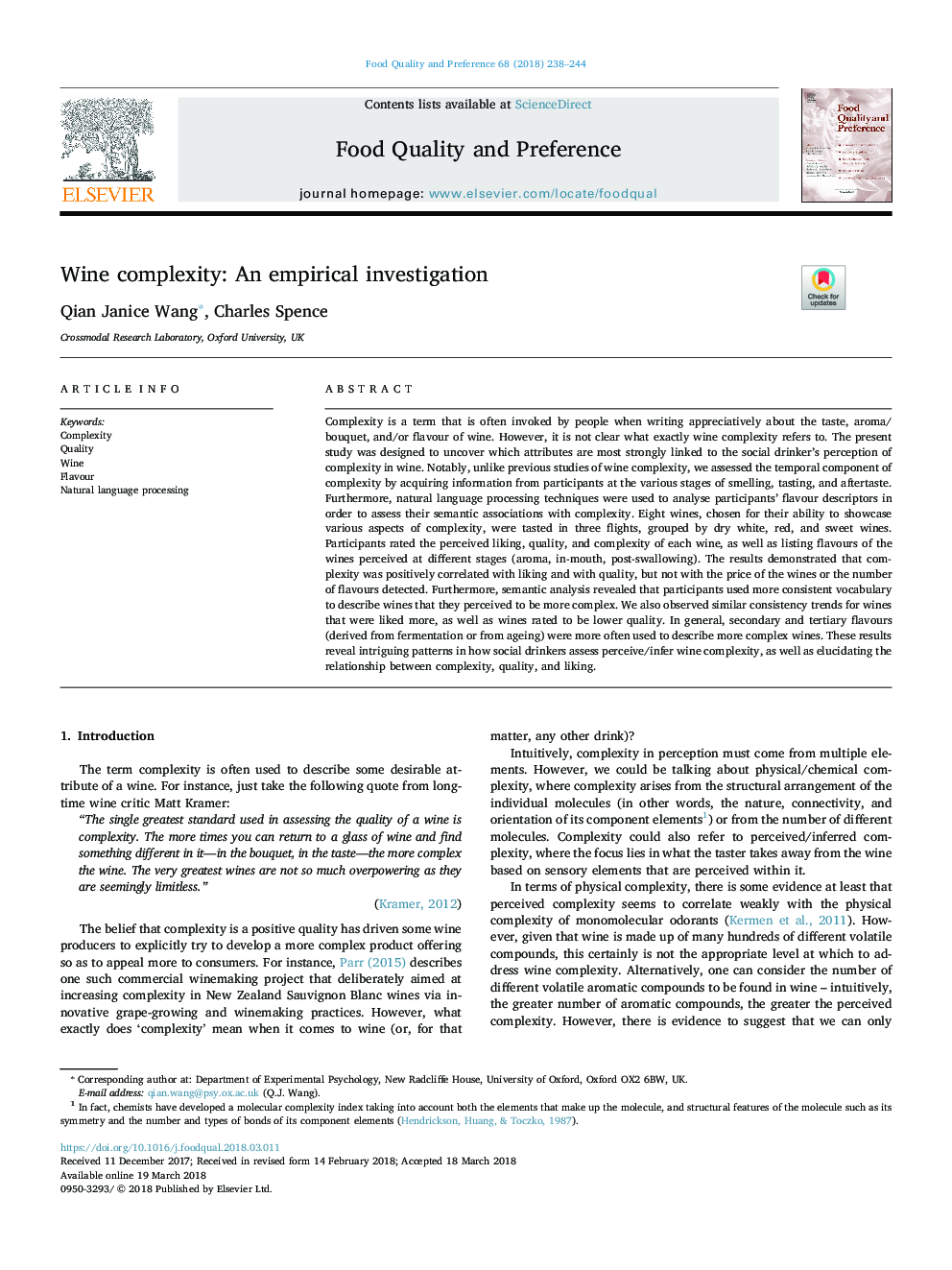| کد مقاله | کد نشریه | سال انتشار | مقاله انگلیسی | نسخه تمام متن |
|---|---|---|---|---|
| 8838459 | 1613132 | 2018 | 7 صفحه PDF | دانلود رایگان |
عنوان انگلیسی مقاله ISI
Wine complexity: An empirical investigation
ترجمه فارسی عنوان
پیچیدگی شراب: تحقیق تجربی
دانلود مقاله + سفارش ترجمه
دانلود مقاله ISI انگلیسی
رایگان برای ایرانیان
کلمات کلیدی
پیچیدگی، کیفیت، شراب، عطر و طعم، پردازش زبان طبیعی،
ترجمه چکیده
پیچیدگی یک اصطلاح است که اغلب در هنگام نوشتن با احترام در مورد طعم و مزه، عطر / دسته گل، و / یا عطر و طعم شراب مورد استفاده مردم است. با این حال، مشخص نیست دقیقا چه پیچیدگی شراب به آن اشاره دارد. این مطالعه به منظور کشف کردن ویژگی هایی که بیشتر به ارتباط نگرش اجتماعی پیچیدگی در شراب مربوط می شود، طراحی شده است. به طور قابل توجهی، بر خلاف مطالعات گذشته پیچیدگی شراب، ما با بررسی اطلاعات از شرکت کنندگان در مراحل مختلف بوی، مزه و بعد از ظهر، جزئی از زمان پیچیدگی را ارزیابی کردیم. علاوه بر این، تکنیک های پردازش زبان طبیعی برای تجزیه و تحلیل توصیف عطر و طعم شرکت کنندگان به منظور ارزیابی ارتباطات معنایی آنها با پیچیدگی مورد استفاده قرار گرفت. هشت شراب که برای توانایی آنها برای نمایش جنبه های مختلف پیچیدگی انتخاب شده بودند، در سه پرواز دسته بندی شده با سفید سفید، قرمز و شراب شیرین خوابیده شدند. شرکت کنندگان امتیاز خواسته، کیفیت و پیچیدگی هر شراب، و همچنین لیست طعم دهنده های شراب های درک شده در مراحل مختلف (عطر، در دهان، پس از بلع) را ارزیابی کردند. نتایج نشان داد که پیچیدگی با میل و کیفیت با کیفیت ارتباط دارد، اما نه با قیمت شراب و یا تعداد طعم های شناسایی شده. علاوه بر این، تجزیه و تحلیل معنایی نشان داد که شرکت کنندگان واژگان سازگار تر را برای توصیف شراب هایی که پیچیده تر می شوند، استفاده می کنند. ما همچنین روند مشابهی را برای شراب هایی که دوست داشتنی تر هستند و همچنین به عنوان شراب هایی با کیفیت پایین رتبه بندی شده را مشاهده کردیم. به طور کلی، طعم های ثانویه و ثانویه (مشتق شده از تخمیر و یا پیری) اغلب برای توصیف پیچیده تر شراب استفاده می شود. این نتایج نشان می دهد الگوهای جالب توجه در مورد اینکه چگونه نوشیدنی های اجتماعی، پیچیدگی شراب درک / درگیری را ارزیابی می کنند، و نیز توضیح رابطه بین پیچیدگی، کیفیت و میل.
موضوعات مرتبط
علوم زیستی و بیوفناوری
علوم کشاورزی و بیولوژیک
دانش تغذیه
چکیده انگلیسی
Complexity is a term that is often invoked by people when writing appreciatively about the taste, aroma/bouquet, and/or flavour of wine. However, it is not clear what exactly wine complexity refers to. The present study was designed to uncover which attributes are most strongly linked to the social drinker's perception of complexity in wine. Notably, unlike previous studies of wine complexity, we assessed the temporal component of complexity by acquiring information from participants at the various stages of smelling, tasting, and aftertaste. Furthermore, natural language processing techniques were used to analyse participants' flavour descriptors in order to assess their semantic associations with complexity. Eight wines, chosen for their ability to showcase various aspects of complexity, were tasted in three flights, grouped by dry white, red, and sweet wines. Participants rated the perceived liking, quality, and complexity of each wine, as well as listing flavours of the wines perceived at different stages (aroma, in-mouth, post-swallowing). The results demonstrated that complexity was positively correlated with liking and with quality, but not with the price of the wines or the number of flavours detected. Furthermore, semantic analysis revealed that participants used more consistent vocabulary to describe wines that they perceived to be more complex. We also observed similar consistency trends for wines that were liked more, as well as wines rated to be lower quality. In general, secondary and tertiary flavours (derived from fermentation or from ageing) were more often used to describe more complex wines. These results reveal intriguing patterns in how social drinkers assess perceive/infer wine complexity, as well as elucidating the relationship between complexity, quality, and liking.
ناشر
Database: Elsevier - ScienceDirect (ساینس دایرکت)
Journal: Food Quality and Preference - Volume 68, September 2018, Pages 238-244
Journal: Food Quality and Preference - Volume 68, September 2018, Pages 238-244
نویسندگان
Qian Janice Wang, Charles Spence,
